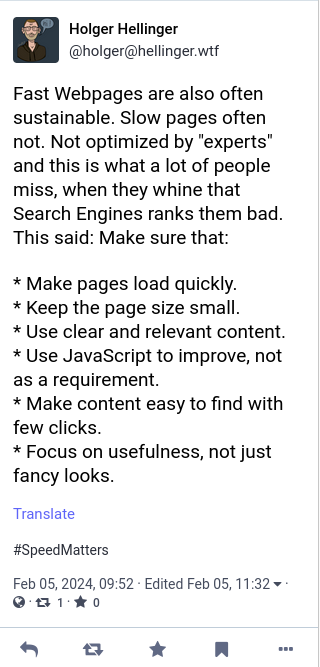
- An SEO optimization checklist is unavoidable in web publishing.
- Using older posts can breathe new life into rankings
- Don’t fall into the ‘AI’ trap.
One of the realities of website publishing today is that the visibility of your content is determined to a large degree by the algorithms that surface a site in an online search. Optimizing your website for the best results is, therefore, a part of online publishing as integral as good grammar and an attractive writing style. Using an SEO optimization checklist can help you achieve reliable results.
READ NEXT

Google search sucks, thanks SEO
And while it’s true that ‘Google is not the internet,’ SEO has to be embraced if you’re at all interested in as many people as possible reading your content and absorbing your message. Google and many other search engines have their own agenda in terms of what they surface most readily, but among the carefully constructed caveats and provisos designed to shape the modern internet’s content to their own ends, many SEO ‘rules’ comprise aspects of a page that include readability, legibility for assistive web tools, relevancy, popularity and the freshness of information. Taken objectively, these are generally positive influences on websites’ content.
It’s easy to fall too far into the website optimization pit. Sites written primarily with SERP (search engine results pages) in mind are easy to spot – repetitive use of keywords in body text and sub-headings, plus very little interesting content, are key indicators. However, it is possible to strike a balance between the value of your content to actual human readers and its perceived value for search algorithms. One way to help achieve this is to ensure that older content is refreshed.

Source: Fosstodon.org
Refreshing content should not necessarily mean re-spinning it, (that is, rewriting each sentence, swapping out adjectives for synonyms, swapping main and subordinate clauses, and so on).
Content creators should consider refreshing content as a revision process with particular emphasis on bringing the page’s pertinent information up-to-date. In that way, your readers learn from text and media that are more timely, and Google et al. see refreshed content that will, hopefully, be of more interest to readers today.
Finding stagnant pages on websites is a relatively trivial task. Content creation dates supplied by your website’s back end are the obvious metric to begin with, and these can be correlated with analytics from your internal analysis tools.
Most articles receive a spike in interest on publication, then fade away. For news-based content, that’s the natural order of things. Less time-dependent pages could be good targets for a virtual spring clean and spruce-up.
Here’s our search engine optimization checklist for revitalizing the dusty corners of your website.
Updating links and resources
One of the basic tenets of HTML is that text can be represented as hypertext, one aspect of which is that documents are linked. Finding more relevant, up-to-date references and restructuring the sentences around the reference is a great way to bring content forward to the present. Additionally, if what’s being referenced is a field that changes (academic research, for example), readers will appreciate the latest information.
Similarly, it’s worth refreshing your content to reflect changing opinions, either your own or those of the vertical about which you are writing. This type of edit can be made obvious, with clear demarcation, using italics or indented text to tell readers that the article has been updated.
The changing rules
All search engine optimization is guesswork where self-proclaimed experts attempt to backward engineer the closed algorithms used by large search engines. Like any form of guesswork, there are specialists out there whose guesses are better than others, the quality determined by long experience and dedicated testing of changes to content.
But rules of SEO evolve, and it’s worth re-approaching your text and media with a fresh eye that’s informed by some research into what is, as of the present, current practice. It may be that previously optimized web pages need to be changed to reflect current guidelines for best SERP rankings – at which point, you need to update your SEO optimization checklist.
A prime example is readability. Because much web consumption now takes place on mobile devices, ‘readability’ can mean that shorter paragraphs interspersed with carefully chosen media have the advantage over thick walls of text (which are difficult to read on a moving bus, for example). Changing your pages’ structure may be advantageous within the limits of house style.

Here’s one. “Teaching an Old Dog New Tricks” by Fouquier ॐ is licensed under CC BY-NC 2.0.
Not using large language models
Like any other tool, using a large language model (Copilot, ChatGPT, etc.) can be effective in certain circumstances. LLMs act as relatively useful proxies for web searches, so if you’re looking to find supporting materials for your pages, LLMs can unearth nuggets of information that would otherwise take much longer to find using ‘traditional’ search.
But if we consider the text output of LLMs to be an amalgam of available information online, their output should not be used to create original content. By pulling together many thousands of websites for learning, LLMs produce literally average output. The models are poor at differentiating useful information from third-rate content, and so produce something in the middle: the sum mean.
Given that your content should be unique and informative rather than only readable, using ChatGPT to write for you is wrong on every level.
Journalists and writers are facing redundancy in swathes as short-term profits are prioritized by companies that are happy to embrace second-rate content. If you’re happy with human expression being replaced by algorithms that regurgitate other people’s work (or, more accurately, predict what the next word in a sentence is likely to be, based on other people’s work), then LLMs are a fine choice. You may also want to use the phrase artificial intelligence incorrectly.
Conclusions
Whether your web pages promote a commercial product or express your inner life, it’s worth bearing in mind that the ’web was, and should be, concerned with the dissemination of information. While going through an SEO optimization checklist for best SERP rankings is, in 2024, an undeniable necessity, that fact need not reduce the overall quality of your offerings.
A giant roadside billboard may begin to look dated in terms of its color palette, font choices, strapline, or imagery. Changing those elements to bring a billboard into present relevancy need not change its message. Websites’ pages can be considered similarly.








